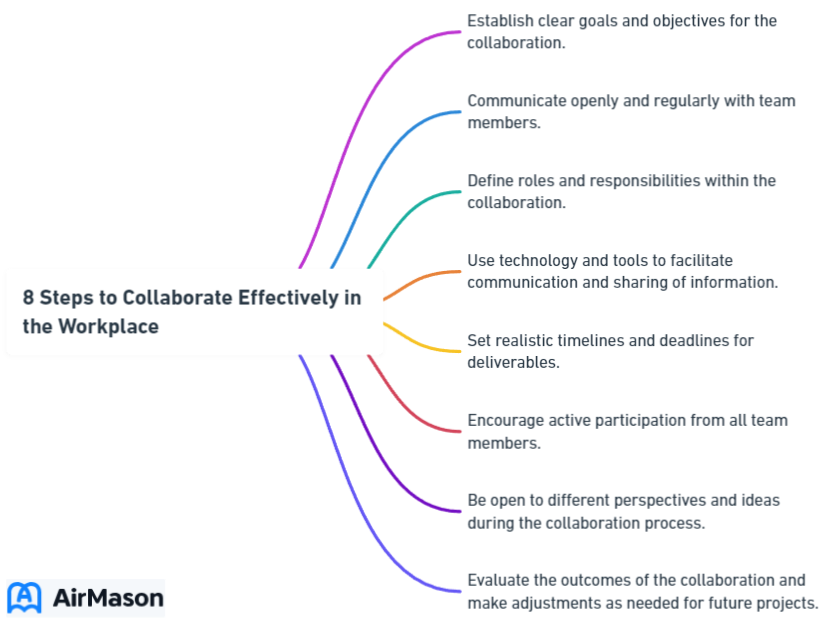![8 Steps to Collaborate Effectively in the Workplace [2023]](https://images.blog.airmason.com/wp-content/uploads/2023/10/8-Steps-to-Collaborate-Effectively-in-the-Workplace-2023-1.png)
In today’s fast-paced business environment, effective collaboration is the cornerstone of success. Mastering the art of teamwork can unlock new levels of innovation, efficiency, and productivity, all while fostering a positive and inclusive work culture. So, how can you harness the power of collaboration and collaborate effectively? In this blog post, we’ll explore the essential components of successful collaboration, provide practical tips for building a collaborative work environment, and offer insights on overcoming common collaboration challenges. Get ready to transform your team dynamics and propel your organization to new heights.
Key Takeaways
- Leaders must foster trust, open communication and clear goals to create effective collaboration in the workplace.
- Utilize tools such as project management software and video conferencing solutions for successful teamwork.
- Develop active listening, conflict resolution, adaptability skills to contribute effectively to team success.
The Power of Effective Collaboration
Successful collaboration goes beyond simply working together; it’s about establishing connections, soliciting feedback, and fostering relationships that make team members feel like they are part of a supportive network. In fact, effective collaboration in the workplace has a significant impact on innovation, problem-solving, and team dynamics.
So, what’s the key to nurturing such a collaborative atmosphere?

Innovation and Creativity
When team members collaborate, they bring together diverse perspectives and ideas, creating a melting pot of innovation and creativity. Cross-functional teams, for example, unite individuals with different skills and perspectives to generate innovative solutions to complex problems. Fostering and championing such collaboration can help organizations tap into unprecedented creativity, propelling their success forward.
Efficient Problem-Solving

Team collaboration, which is the foundation of collaborative efforts, is also the key to efficient problem-solving and decision-making processes. Pooling their wisdom and expertise allows team members to find and execute the most efficient solutions swiftly, thus minimizing the risk of failure.
Through open communication, active listening, and empathy, the entire team, including each team member, can navigate complex situations with ease, fostering a more productive and agile work environment.
Strengthened Team Dynamics
Collaboration can have a profound impact on team dynamics, as it builds trust, improves communication, and fosters a sense of belonging among team members. By cultivating an environment where employees feel comfortable sharing ideas and taking risks, leaders can encourage collaborative behavior and set the stage for a high-performing and cohesive team.
An Organization’s Culture
An organization’s culture is the amalgamation of shared values, beliefs, and practices that define its identity and guide the behavior of its members. It permeates every facet of the workplace, influencing how employees interact, make decisions, and approach their work. A robust organizational culture fosters a sense of belonging and purpose among employees, aligning their efforts towards common goals. It sets the tone for communication, shapes the attitude towards change, and ultimately determines the organization’s overall effectiveness. Furthermore, an organization’s culture is not static; it evolves over time, adapting to new challenges and opportunities. Therefore, nurturing a positive and inclusive culture is paramount for long-term success and employee satisfaction.
Building a Collaborative Work Environment

To create a collaborative work environment, it is essential to understand that it is not a one-time effort; it requires ongoing attention and commitment from team leaders. To build a successful collaborative environment, leaders must establish clear goals and expectations, foster trust and psychological safety, and encourage open communication among team members.
Let’s explore each of these vital components in more detail.
Establish Clear Goals and Expectations
Setting clear goals and expectations is crucial for aligning team members and promoting accountability. By sharing a unified vision and defining each individual’s roles and responsibilities, leaders can ensure that everyone is on the same page and working toward the same objectives. This alignment not only streamlines collaboration but also empowers team members to take ownership of their work and contribute to the team’s success.
Foster Trust and Psychological Safety
Trust and psychological safety form the foundation of successful collaboration. When team members feel safe to share their ideas and take risks, they are more likely to engage in open communication and honest feedback. Leaders can foster trust and psychological safety by:
- Being transparent
- Being approachable
- Being nonjudgmental
- Promoting a culture of empathy and support
Encourage Open Communication
Split text into paragraphs:
Paragraph 1: Open communication is vital for successful collaboration, as it allows for honest feedback, idea sharing, and effective problem-solving. Leaders can encourage open communication by creating a culture of inclusivity, where diverse perspectives are valued and team members feel comfortable voicing their opinions.
Cultivating a supportive company culture and facilitating opportunities for team members, as well as other team members, to express their thoughts and ideas can open up avenues for enhanced collaboration and improved team dynamics.
A Good Company Culture: Fostering Growth and Success
A good company culture is the cornerstone of any thriving organization. It encompasses the shared values, beliefs, and practices that shape the work environment. In companies with a strong emphasis on a good company culture, employees feel a sense of belonging and purpose. This fosters a positive atmosphere, where individuals are not only motivated to excel in their roles but also encouraged to collaborate and innovate. Moreover, a healthy company culture promotes open communication channels, ensuring that feedback is valued and acted upon, leading to continuous improvement. Ultimately, a good company culture becomes a driving force behind employee satisfaction and retention, attracting top talent and setting the stage for long-term success.
Utilizing Collaboration Tools and Technologies

In our modern, technology-dominated world, utilizing appropriate collaboration tools and communication tools becomes critical to bolster teamwork and simplify processes. From project management tools to communication platforms and video conferencing solutions, these resources can facilitate seamless collaboration, even among remote teams.
Project Management Tools
Project management tools like Asana and Trello can help teams stay organized and on track by providing a centralized platform for task management, deadline tracking, and team communication. These tools help maintain team alignment and ensure timely task completion, thereby enhancing productivity and collaboration.
Communication Platforms
Communication platforms such as Slack and Microsoft Teams enable real-time conversations and information sharing, keeping team members connected and informed. Offering a unified hub for collaboration, these platforms aid in sustaining open communication and nurturing camaraderie among team members, irrespective of their geographical location.
Video Conferencing Solutions
With the rise of remote work, video conferencing solutions like Zoom and Google Meet have become indispensable for enabling face-to-face interactions among team members. These tools help narrow the physical distance among employees and provide a platform for idea exchanges, project reviews, and constant connectivity.
Team Culture
Team culture plays a pivotal role in shaping the dynamics and productivity of any group. It encompasses the shared values, norms, and behaviors that define how members interact and collaborate towards common goals. A healthy team culture fosters open communication, trust, and mutual respect among its members. It also encourages diversity of thought and celebrates individual strengths, creating an environment where everyone feels valued and empowered. When team culture is positive and inclusive, it not only boosts morale but also enhances creativity and innovation, leading to higher performance levels and overall success. Nurturing a strong team culture requires consistent effort from both leaders and members, but the benefits reaped are well worth the investment.
Developing Collaborative Skills
Developing collaborative skills, including active listening, conflict resolution, and adaptability, is critical for successful teamwork. Refining these skills enables individuals to contribute more effectively to the team, fostering successful collaboration.
Active Listening
Active listening promotes understanding and empathy among team members, fostering a supportive and collaborative environment. Attentively listening to each other’s input and responding with tact and respect can foster an environment of trust and inclusivity, setting the stage for improved collaboration.
Conflict Resolution
Conflict resolution skills are crucial for addressing disagreements and maintaining a positive team atmosphere. Approaching conflicts with an open mind and prioritizing resolution over blame can enhance team effectiveness and strengthen relationships.
Adaptability and Flexibility
In today’s ever-changing business landscape, adaptability and flexibility are essential for team members to adjust to new circumstances and work styles. Openness to change and embracing new ideas and strategies can maintain team agility and responsiveness, guaranteeing sustained success amidst challenges and uncertainties.
Leading by Example
As a leader, setting an example in collaboration is fundamental. This involves encouraging collaboration, providing opportunities for growth, and recognizing and rewarding teamwork. By demonstrating these behaviors, leaders can create a positive work environment that fosters collaboration and empowers team members.
Encourage Collaboration
Leaders can promote collaboration by:
- Being open to new ideas
- Supporting team members in their efforts
- Fostering an inclusive culture
- Encouraging open communication
These actions can aid leaders in creating a setting that can encourage employees, making them feel at ease sharing their ideas and working collectively towards shared goals.
Provide Opportunities for Growth
Offering opportunities for growth, such as mentorship and professional development programs, can enhance collaboration skills and empower employees to contribute more effectively to the team. Investing in team members’ growth and development can help leaders cultivate a culture of ongoing improvement, propelling organizational success.
Recognize and Reward Teamwork
Recognizing and rewarding teamwork can have several benefits:
- It reinforces the importance of collaboration
- It motivates employees to work together more effectively
- It celebrates achievements and recognizes contributions
- It incentivizes collaborative behavior
By implementing these strategies, leaders can establish a positive work environment that encourages teamwork and yields results.
Overcoming Collaboration Challenges

Collaboration can come with its own set of challenges, such as balancing individuality and teamwork, managing information overload, and navigating remote collaboration. Tackling these challenges head-on and utilizing appropriate tools and strategies can empower teams to surmount obstacles and attain collaborative success.
Balancing Individuality and Teamwork
To strike a balance between individuality and teamwork, it’s essential to acknowledge diverse perspectives while maintaining a unified team vision. Valuing each individual’s distinctive contributions and collaboratively working towards shared goals can help teams strike the right balance and cultivate a result-oriented collaborative environment. By supporting and learning from one another, team members can further enhance their collective performance.
Managing Information Overload
Splitting the text into paragraphs:
Paragraph 1: Information overload can be a significant challenge in the age of technology. To manage this issue, teams can use tools that help organize and prioritize information effectively.
Streamlining communication and concentrating on the most crucial data can help teams maintain focus and productivity in a collaborative scenario, so it’s important to make sure everyone is on the same page.
Navigating Remote Collaboration
Navigating remote collaboration requires leveraging technology and fostering a strong team culture, despite physical distance. Some strategies for successful remote collaboration include:
- Utilizing collaboration tools and technologies
- Prioritizing open communication
- Building team bonding activities
- Establishing clear goals and expectations
- Providing regular feedback and recognition
By implementing these strategies, remote teams can overcome challenges and sustain a cohesive and collaborative work environment.
Summary
In conclusion, collaboration is the key to unlocking innovation, efficiency, and success in today’s competitive business landscape. By fostering a collaborative work environment, leveraging tools and technologies, developing collaborative skills, and leading by example, teams can overcome challenges and achieve collaborative success. By embracing the power of collaboration, you can propel your organization to new heights and drive lasting, positive change.
Frequently Asked Questions
What does collaborate effectively mean?
Collaborating effectively means engaging with others, gathering feedback and improving relationships to achieve a common goal and increased productivity, performance, and trust.
Why is it important to collaborate effectively?
Collaboration is important as it promotes an environment of increased innovation, efficient processes, successful outcomes and improved communication. Working together allows teams to listen to and learn from each other, enabling them to achieve their collective objectives and become more competitive in their market.
What are the three steps of effective collaboration?
Effective collaboration requires setting goals, sharing vulnerably and supporting diverse ideas and skills. Confirming the people with whom strong relationships exist, and understanding the complimentary skills that mesh together is also necessary. Finally, ask what enables strong ongoing collaboration to take place.
What is an example of collaborate effectively?
Collaborating effectively in the workplace could be demonstrated through brainstorming, group discussions, and reaching consensus about processes or analyzing problems and coming up with solutions.
What are some examples of collaboration tools and technologies?
Collaboration tools and technologies like Asana, Trello, Slack, Microsoft Teams, Zoom, and Google Meet help teams communicate effectively and stay connected.